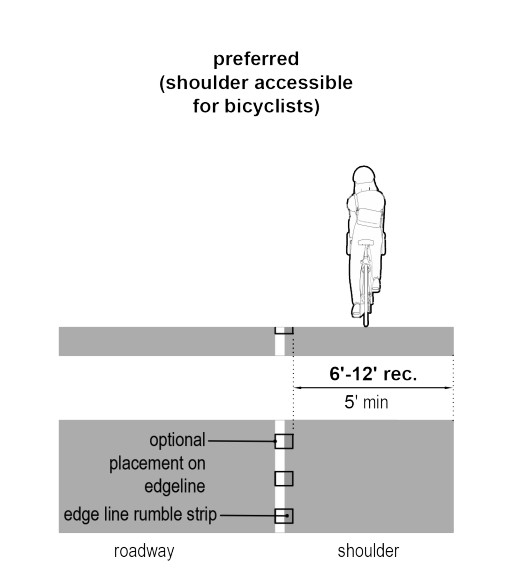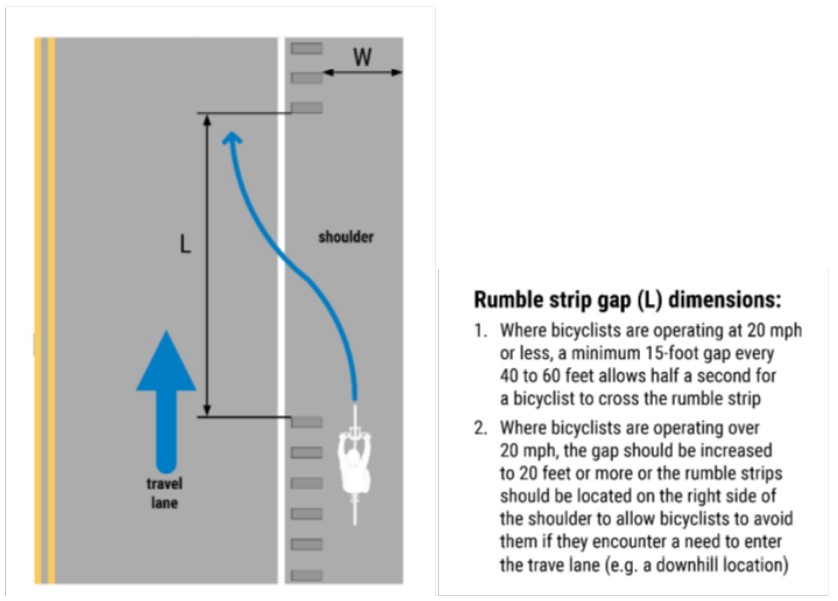18.4.6 Bike Accessible Shoulders

Figure 18-24: Example Bike Accessible Shoulder Schematic
Bike accessible shoulders are one-way facilities on a roadway that carry bicycle traffic in the same direction as adjacent motor vehicle traffic. A bike accessible shoulder is one that is at least as wide or wider than a bike lane to accommodate bicyclists and paved to provide a smooth, solid surface across its width. While the bike accessible shoulder distinguishes areas for bicyclist and automobile movement, bicyclists may leave the shoulder to pass other cyclists or avoid debris and other traffic conflicts.
18.4.6.1 Application
See
for guidance on recommended shoulder width. In rural environments, see
for guidance on desirable shoulders widths.
18.4.6.2 Width
For any given roadway, the determination of the appropriate paved shoulder width should be based on the roadway’s context and traffic conditions following the guidance in
for shoulder requirements on new location and reconstruction projects. However, it should be noted that the shoulders in the RDM may consist of graded (soft) and paved (hard) surfaces. To ensure accommodation of bicyclists, it is desirable for paved shoulders to conform to the widths in
.
Some shoulders should be up to 10-ft wide adjacent to higher speed roadways as indicated in
to allow bicyclists to operate with more separation to the high-speed traffic. Roadways indicated in TxDOT’s Bicycle Tourism Trails Study should be designed with a 10-ft shoulder (8-ft minimum) shoulder, a shared use path, or another locally preferred facility type should be available. Contact TxDOT’s Public Transportation Division (PTN) for more information. The minimum widths for a bike accessible shoulder are defined below.
- A minimum width of 4-ft is allowable in low speed (45 mph or less) conditions;
- A minimum width of 5-ft is allowable for high-speed conditions; and
- A minimum width of 5-ft is required for shoulders adjacent to bridge railings, MBGF, and other vertical elements.
The width of the bike accessible shoulder does not include rumble strips. See below for more information on rumble strip considerations.
18.4.6.3 Signing and Marking
A solid white edge line (6-in wide) should be placed between the shoulder and travel lane.
Bike accessible shoulders typically do not have bike lane markings, but they may include signage indicating the presence of bicyclists.
A bike accessible shoulder may transition to a bike lane with signage and markings at intersections to communicate the exclusive use of the space by bicyclists.
18.4.6.4 Bicycle Design Speed
Not applicable as the roadway will be designed to accommodate motorist target design speeds which will exceed bicyclists.
18.4.6.5 Cross Slope and Grade
Cross slopes of 1 percent are more comfortable for people with disabilities and people bicycling with more than two wheels (e.g., cargo bike, adult tricycles, or trailers) while allowing adequate conveyance of drainage; however, cross slope may match existing roadway conditions without a maximum where necessary.
18.4.6.6 Other Considerations
Rumble strips are used to warn the driver that they are leaving the travel way and therefore may have a beneficial effect on the safety of bicycles using the shoulder. If rumble strips are to be used, or are anticipated in the future, allowances should be made in the shoulder to provide an adequate width for bike accommodations beyond the rumble strip.
Profile pavement markings serve a similar function as milled rumble strips and can be considered as an option to avoid a reduction in the width of the accessible shoulder. Where bicycle traffic is expected, rumble strips should be designed as follows to minimize crash risk for bicyclists (see
). Refer to the latest RS Standards for additional guidance on rumble strips.
Periodic gaps (
) should be provided to allow bicyclists to safely enter or exit a shoulder as needed (e.g., to avoid debris, pass other bicyclists or disabled vehicles, make left turns, etc.) without having to ride over the rumble strips.
- Where bicyclists are operating at 20 mph or less, a minimum 15-ft gap every 40 to 60-ft allows half a second for a bicyclist to cross the rumble strip; and
- Where bicyclists are operating over 20 mph, the gap should be increased to 20- ft or more or the rumble strips should be located on the right side of the shoulder to allow bicyclists to avoid them if they encounter a need to enter the travel lane (e.g., a downhill location).

Figure 18-25: Rumble Strip Placement in a Shoulder

Figure 18-26: Rumble Strip Design and Gap Placement